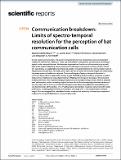Communication breakdown : limits of spectro-temporal resolution for the perception of bat communication calls
Abstract
During vocal communication, the spectro-temporal structure of vocalizations conveys important contextual information. Bats excel in the use of sounds for echolocation by meticulous encoding of signals in the temporal domain. We therefore hypothesized that for social communication as well, bats would excel at detecting minute distortions in the spectro-temporal structure of calls. To test this hypothesis, we systematically introduced spectro-temporal distortion to communication calls of Phyllostomus discolor bats. We broke down each call into windows of the same length and randomized the phase spectrum inside each window. The overall degree of spectro-temporal distortion in communication calls increased with window length. Modelling the bat auditory periphery revealed that cochlear mechanisms allow discrimination of fast spectro-temporal envelopes. We evaluated model predictions with experimental psychophysical and neurophysiological data. We first assessed bats' performance in discriminating original versions of calls from increasingly distorted versions of the same calls. We further examined cortical responses to determine additional specializations for call discrimination at the cortical level. Psychophysical and cortical responses concurred with model predictions, revealing discrimination thresholds in the range of 8-15 ms randomization-window length. Our data suggest that specialized cortical areas are not necessary to impart psychophysical resilience to temporal distortion in communication calls.
Citation
Hörpel , S G , Baier , A L , Peremans , H , Reijniers , J , Wiegrebe , L & Firzlaff , U 2021 , ' Communication breakdown : limits of spectro-temporal resolution for the perception of bat communication calls ' , Scientific Reports , vol. 11 , 13708 . https://doi.org/10.1038/s41598-021-92842-4
Publication
Scientific Reports
Status
Peer reviewed
ISSN
2045-2322Type
Journal article
Description
Funding: Open Access funding enabled and organized by Projekt DEAL. This work was supported by the Human Frontier Science Program (Grant RGP0058 to UF).Collections
Items in the St Andrews Research Repository are protected by copyright, with all rights reserved, unless otherwise indicated.

